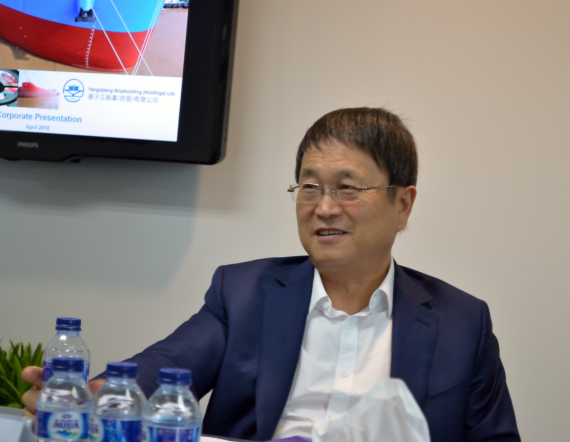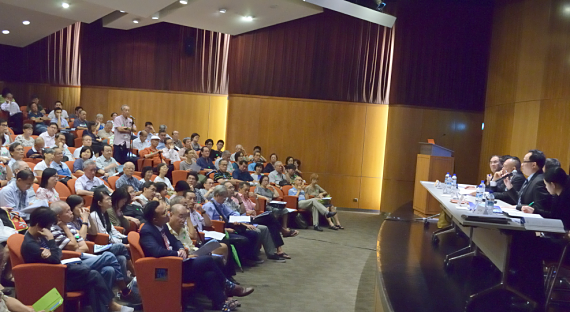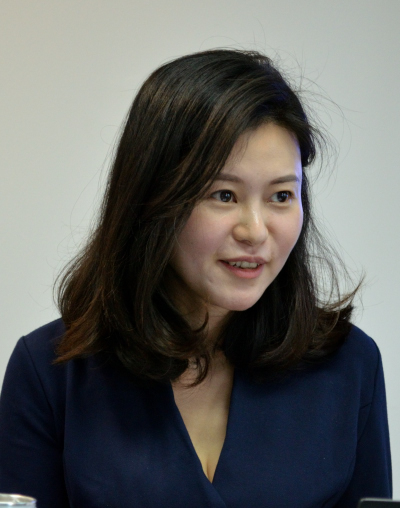 Yangzijiang Shipbuilding Executive Chairman Ren Yuanlin cautioned analysts on the impact of high steel prices and a strong yuan at its 1QFY2018 results briefing last Friday. (Photo by Sim Kih) Yangzijiang Shipbuilding Executive Chairman Ren Yuanlin cautioned analysts on the impact of high steel prices and a strong yuan at its 1QFY2018 results briefing last Friday. (Photo by Sim Kih)
Faced with margin erosion from a stronger RMB and higher steel prices, Yangzijiang Shipbuilding mitigated the lower shipbuilding profitability by increasing its investment income by RMB 99 million year-on-year in 1QFY2018.
Net interest income was RMB 299 million, contributing 25.8% to Group gross profit (1Q2017: 18.6%)
|
The Group has secured new orders for 9 vessels year-to-date with a total contract value of US$268 million. The new orders include one 180k-DWT bulk carrier, seven 82k-DWT bulk carriers, and one 83.5k-DWT combination carrier.
Its outstanding order book was US$4.5 billion as at 31 March 2018, comprising of 121 vessels that will keep its yards highly utilized until 2020.
Other highlights of 1QFY2018:
- Income from financial assets at amortized cost (formerly classified as held-to-maturity assets) was significantly higher by 45.3% at RMB 302.0 million
- Higher charter income lifted segment revenue from other shipbuilding related businesses by 37.4% yoy to RMB 88.1 million.
- Gross profit margin declined by 1.7 percentage points yoy to 17.3% due to higher raw material prices and RMB appreciation against the USD since the beginning of 2017.
For more information, refer to its 1QFY2018 results media release here.
 @ AGM. Photo by Sim Kih.
@ AGM. Photo by Sim Kih.
|
Financial Highlights |
1QFY2018 |
yoy change |
|
Revenue |
4,963.3 |
6% |
|
Gross profit |
859.6 |
-3% |
|
Gross margin |
17.3% |
-1.7ppt |
|
Net profit attributable to shareholders |
595.1 |
-11% |
Below is an excerpt of the questions raised at the Group's 1QFY2018 results briefing, and the replies provided by Executive Chairman Ren Yuanlin and CFO Liu Hua.
Q: Why is your investment income higher by almost RMB 100 million?
We have remained one of the leading shipbuilding enterprises in China because the banks have been extending to us the largest available credit limit. A second reason was the optimization of our huge cashflow via investment products.
|
“Gross margins for shipbuilding contracts are lower because of a stronger RMB and increased cost of steel. On the other hand, the proportion of contribution from our financial assets to Group profitability increased in 1QFY2018.” - Liu Hua |
Our huge cashflow plus the large credit limit extended to us has increased our creditworthiness.
The case of New Century Shipbuilding, a private yard that disbursed most of its booked profit (a large portion was repatriated to Singapore), shows how important cash reserves are.
After it did that, its bank demanded deposits amounting to 100% of its purchase order value for letters of guarantee. Before it disbursed its profit, the bank did not require any deposit.
From being a "rich man", the yard became a "poor man" after it distributed its profits. That is why we maintain a high financial asset balance.
That is also why we are unlikely to spin-off our investment segment.
Q: What is the profit and margin outlook for the first and second half of this year?
1HFY2018 gross profit and margins will remain decent because we have been delivering a few large vessels, including 5 units of 10k TEU containerships to Seaspan. In 2Q2018, we are scheduled to deliver a 400k-DWT Valemax bulk carrier. We plan to deliver most of the 12 units of 11.8k TEU containerships for Pacific International Lines this year.
The contracts for these vessels were secured before 2017, at a time when the USD was relatively strong at RMB 6.20 to RMB 6.30. These vessels were constructed when the cost of steel was relatively low.
| Stock price | S$1.17 |
| 52-week range | S$1.11 - S$1.74 |
| Market cap | S$4.6 billion |
| PE (ttm) | 7.5 x |
| Dividend yield | 3.88% |
| Gross Gearing | 14.3% |
| Source: Bloomberg / Company | |
The gross profit margin could go down significantly in the second half of this year because we will be delivering vessels for orders secured in 2017 when the USD was about RMB 6.60 and steel prices reached close to RMB 4,800 per ton.
Returns on our investment segment will be generated by assets that generate about 8%. We have assets under management of about RMB 10 billion. Many of these investments will mature in the first half of this year.
Our current investment portfolio has a much higher return of about 12% or more. The higher returns will mitigate the unprofitability of our shipbuilding business. We intend to grow our investment portfolio over the next few quarters. We also need the strong cashflow from our portfolio to pay dividends to our shareholders, senior management and directors.
Our target for our shipbuilding business is to achieve a gross margin of 8%. However, whether or not we accept an order also depends on the foreign exchange rate and steel prices.








